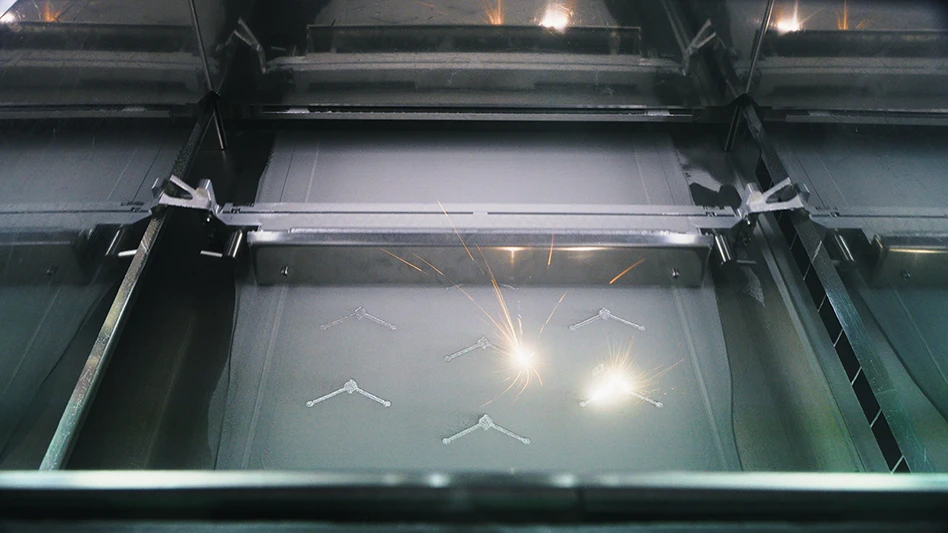 A range of prosthetic components precision machined on an OMAX 2626 | xp JetMachining Center using OMAX-developed miniature nozzles.The smaller the abrasive waterjet stream is, the better for micro-medical parts machining. Unfortunately, it is a concept that is easier said than done, especially when one considers the goal is to generate a stream of abrasive slurry able to accurately cut features as tiny as 0.002".
A range of prosthetic components precision machined on an OMAX 2626 | xp JetMachining Center using OMAX-developed miniature nozzles.The smaller the abrasive waterjet stream is, the better for micro-medical parts machining. Unfortunately, it is a concept that is easier said than done, especially when one considers the goal is to generate a stream of abrasive slurry able to accurately cut features as tiny as 0.002".
A jet stream of only water could easily be engineered to a diameter of 0.002". The challenges arise when an abrasive is added to the mix. That’s when waterjet streams become thicker and problems begin to surface.
However, Omax has made significant advances in meeting the micromachining requirements of the medical industry. Engineers have successfully overcome the challenges associated with shrinking waterjet streams for micromachining by developing special micro-abrasive nozzles.
The company continually works on further downsizing its abrasive waterjet nozzles, and has its sights set on eventually being able to machine part features well below 100μm (0.004"). OMAX has been conducting feasibility investigations into the development of micro-abrasive waterjet nozzles for machining part features as small as 50μm (0.002").
Shrinking the size of abrasive waterjet nozzles requires overcoming two main hurdles – non-uniform abrasive feeding and nozzle clogging.
As nozzle orifices and mixing tubes become sufficiently smaller, a water column remains within the bores of mixing tubes due to a capillary effect. With lower speed at the front of the abrasive waterjet, jet stream then impinges on the surface of the water column, causing back splash that wets any residual abrasive left in the mixing chamber and feed port entrance. After many on-off cycles, accumulation of these wet abrasives eventually clog the nozzle.
Attempts have been made to remedy these problems using vacuum assist and water flushing. But, such remedies typically result in bulky nozzle designs requiring several ports, connecting tubes, ejectors, water pumps, control software, and other devices or appendages. These can greatly hinder system maneuverability, add operational complexity, decrease efficiency, and increase cost.
Engineers at OMAX took a different approach with the design of the company’s micro-nozzles. Under the support of a National Science Foundation SBIR Phase I Grant and a Phase IB supplement, OMAX engineers developed several proprietary processes (patents pending) that minimize nozzle clogging and abrasive-flow intermittency without the use of vacuum assist or water flushing.
One process uses a miniature nozzle design with orifice and mixing tube diameters of 0.18mm and 0.38mm. OMAX engineers were able to successfully operate the nozzle. There are also several nozzles currently under development at OMAX that incorporate mixing tubes as small as 0.2mm, and work is being done on approaches toward abrasive waterjet micro-machining using relatively larger nozzle combinations.
With medical applications in mind, OMAX engineers applied one of their recently developed miniature nozzles to an OMAX 2626 model JetMachining Center, equipped with the company’s rotary axis accessory to fabricate nearly 3D parts. In addition, the combination of the miniature nozzle, the rotary axis, and OMAX’s A-Jet tilting head will provide medical shops with the capability to machine tiny complex 3D components.
For precision medical work, an OMAX 2626 | xp JetMachining Center, with a positioning accuracy two to three times higher than its 2626 counterpart, can also be equipped with OMAX’s Tilt-A-Jet system. When in use, the system’s software automatically calculates and off-sets the natural taper that results from the abrasive waterjet stream for zero-taper cutting operations.
Advantages
Abrasive waterjet machining relies on the erosion of the target material by abrasive particles accelerated to supersonic speeds via the high-speed abrasive waterjet forced through the machine orifice. This process is a form of micro-machining by individual abrasives impinging on the target material. Such a micro-machining process differs from the macro-machining process by most contact tools that often experiences considerably high wear rates.
The waterjet not only transfers its kinetic energy to entrained abrasives, but also serves as a coolant to carry away the heat generated by the erosion process. As a result, abrasive waterjet machining is a cold cutting process that does not induce thermal damage on workpieces.
Such damage could include the creation of heat-affected zones that often lead to surface hardening and modification of a parent material’s chemical properties. Abrasive waterjet machining is also a mechanical process that is environmentally safe as compared with others, such as photochemical etching, a process that produces toxic or hazardous waste.
OMAX Corp.
Kent, WA
omax.com

Explore the January February 2011 Issue
Check out more from this issue and find your next story to read.
Latest from Today's Medical Developments
- HERMES AWARD 2025 – Jury nominates three tech innovations
- Vision Engineering’s EVO Cam HALO
- How to Reduce First Article Inspection Creation Time by 70% to 90% with DISCUS Software
- FANUC America launches new robot tutorial website for all
- Murata Machinery USA’s MT1065EX twin-spindle, CNC turning center
- #40 - Lunch & Learn with Fagor Automation
- Kistler offers service for piezoelectric force sensors and measuring chains
- Creaform’s Pro version of Scan-to-CAD Application Module





